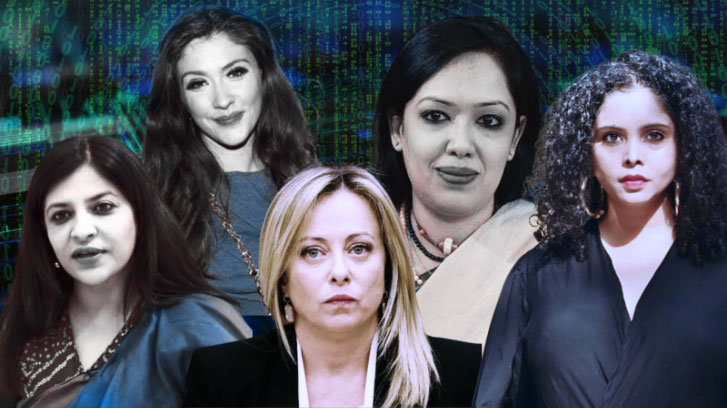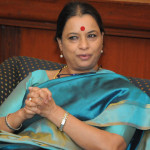Imagine yourself as a woman from a deeply traditional, patriarchal background, striving to carve out a meaningful path in life despite familial resistance. Through dedication and perseverance, you excel in your studies, eventually earning a position of influence. After enduring numerous struggles within your conservative family, you finally gain their acceptance to pursue your aspirations, which are inclined towards politics. Despite facing formidable obstacles, your remarkable contributions earn you a chance to contest in elections, a monumental step towards realizing your dreams. Then, one day, news surfaces about you in the media like the same which was experienced by Italy’s Prime Minister or an Indian journalist Rana Ayyub — a deep fake pornographic video, engineered to malign your reputation. In this distressing scenario, what would you do? How would you respond to this injustice? What steps would you take, and what recommendations would you offer to authorities? Let us know in the comments section. Till then let’s see a bit about gender, AI, and election
In India, despite constitutional provisions granting equal suffrage rights, societal norms and institutional biases often impede women’s full participation in electoral processes. Factors such as societal conditioning, limited resources, and traditional gender roles have historically constrained women’s involvement in politics. But nowadays, things have changed. Women’s participation in elections has increased, starting with the Swadeshi movement (1905) in Bengal, from where the beginning of Indian female participation in nationalist activities then the representation of women in the LokSabha from the first general elections(1952) where the number of women members got elected is 22 till to the latest 17th Lok Sabha elections (2019) where the count went to 78 . In the 2019 elections, approximately 9% (726) of the candidates were female. Despite the Women’s Reservation Bill (2023) which was passed on the 21 September, in the country’s new Parliament building, which passed both houses of Parliament almost unanimously—with just two votes against—will ensure that women occupy at least 33 per cent of the seats in state legislative assemblies and the Lok Sabha, the lower house of Parliament, but still political parties have not increased the number of female candidates in this upcoming Lok Sabha election.
In the 17th Lok Sabha in India, only 14.4 % of members are women, sharply lower than major economies. In Mexico, it is 48.2 percent, France 39.7 per cent, Italy 35.7 per cent, UK 32 per cent and Germany 30.9%, as per data analyzed by SBI’s Economic Research Department. Countries such as Sweden & Norway, and South Africa have more than 45 per cent women representation in their national legislatures. India’s neighbor Bangladesh has 21 per cent women in the national legislatures.
According to SBI’s Economic Research Department, if the current voting trend continues, the total voter turnout in 2024 might reach around 68 crore, with an estimated 33 crore women voters, making up roughly 49 percent of the total electorate. Interestingly, out of the 23 major states that had state assembly elections in the last five years, women turned out to vote more than men in 18 states. What’s even more noteworthy is that out of these 18 states, the same government was reelected in 10 states where women showed higher turnout than men. Despite the significant influence of women voters in determining election outcomes,
why do governments hesitate to allocate seats to women candidates? Do political parties that claim to prioritize women’s representation genuinely provide opportunities for women to contest elections, or are they merely making empty promises to garner votes, exploiting the higher count of women voters compared to men? Is it possible that the patriarchal norms ingrained in Indian society discourage men from accepting women in decision-making roles within politics and governance? Are political candidates guilty of making hypocritical statements?
Feel free to share your thoughts, additional questions, or answers in the comments section below.
Till then we can delve into the reasons behind this phenomenon in a future discussion or perhaps in another article.


Artificial Intelligence and the Political Landscape
The political landscape is changing due to the rapid development of generative AI technology, which presents both opportunities and difficulties for the next election. According to the TIME magazine, this year, at least 64 countries (plus the European Union), more than two billion people across the globe will have the opportunity to participate in numerous significant elections, influencing policy and the future of democracy. These pivotal votes coincide with rapid advancements in artificial intelligence, underscoring the evolving landscape of governance and technology.
AI software tools like deep fakes, audio manipulation, image manipulation, text generation and so on. Deepfake videos are a form of synthetic media that uses artificial intelligence to swap out the faces of people in videos. When done well, these realistic videos can be quite convincing, making a puppet out of the person featured in the film.
This sophisticated manipulation like deep fake videos, voice cloning that could massively used during the election campaign poses a grave threat to women in politics, not only in politics but also in their careers like in the cinema industry we saw a similar situation where bollywood actress videos have been circulating who are vulnerable to online harassment and character assassination, and recently one of the political party in Tamil Nadu used the AI deep fake created by AI media Tech firm.. In a country like India, where digital literacy varies widely, the proliferation of deepfake technology exacerbates the challenge of combating misinformation and safeguarding electoral integrity. Deepfakes, particularly when weaponized against women, perpetuate gender-based violence in both public and private spheres. By disseminating falsified videos depicting female politicians in compromising situations, malign actors seek to undermine their credibility and deter their political ambitions. This insidious form of online violence not only targets individual women but also sends a chilling message that women are unwelcome in politics, perpetuating a cycle of exclusion and intimidation.
AI, Women and Politics
In a world where seeing is believing, deepfake technology poses a unique threat, particularly in the political arena. The ability to clone voices and superimpose faces onto existing video clips has become a new tool in the arsenal of misinformation. This is particularly concerning in a country like India, where internet consumption is high and digital literacy is varied. The rise of platforms like The Indian Deep Faker, offering personalized political ad campaigns, underscores this growing challenge.
Deep fakeness is definitely being weaponized against women politicians. Women, both in the public eye and as private citizens, are particularly vulnerable to online manipulation. Deepfake technology is being widely used to put female politicians in fake but compromising positions. Realistic deepfakes of women and minorities have long been potent vectors of tech-facilitated gender-based violence. In a blockbuster election year punctuated by new generative AI threats, the impact of online violence against women will have a silencing effect on the political ambitions and engagement of women and girls, decreasing their presence and voice in politics and public life. It targets individual women to harm them or drive them out of public life, but also sends a message that women don’t belong in politics—as voters, candidates, office holders, or election officials. This falls into a wider trend of abuse targeting women in the public sector. Sexism, harassment, and violence against women candidates in elections are quickly becoming a global problem, impeding gender equality and undermining the foundations of democracy.
Deepfake technology in Indian politics and elections is a double-edged sword. While it offers innovative ways for political communication, its potential for misuse is immense. As we move towards more technologically driven elections, the challenge will be to maintain a balance between innovation and integrity.
There is a need for digital literacy among people. Tech-facilitated gender-based attacks can be a solvable problem. We need stronger legislation, better access to data, and an eye on the ground through election observers to create a new precedent for the online safety of women and girls. The need of the hour is a concerted effort involving technological solutions, legal frameworks, and public awareness to safeguard the sanctity of democratic processes. In conclusion, the advent of deepfake technology presents both a formidable challenge and a call to action. As we navigate the complexities of modern politics, let us know in the comments
How to harness the power of innovation to uphold the principles of democracy and ensure equal participation for all, regardless of gender? How should the Government regulate AI? What steps that the Ministry of Electronics and Information Technology take? Let us know in the comments.




